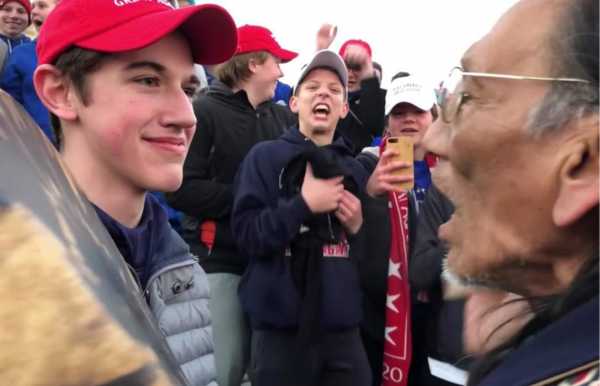
Why is the Covington Catholic controversy still the nation’s biggest story?
It started simply enough. A short viral video shot on Friday shows a group of white teens in “Make America Great Again” hats surrounding a small group of Native American demonstrators, including an elder from the Omaha tribe named Nathan Phillips. One of the kids, identified as Covington Catholic High School student Nick Sandmann, gets up in Phillips’s face and smirks, unaffected by Phillips’s drumming. It looks like a straightforward story of privileged racist white kids harassing a peaceful Native protester.
But shortly after the clip went viral, to universal and at times vitriolic condemnation, a pushback began in right-of-center media. They argued that mainstream media and left-wing activists alike were being unfair to the kids, who were actually defending themselves from insults and harassment from a separate group of protesters, members of the fringe Black Israelite movement. Even President Trump weighed in:
In response, some left-liberal commentators defended the initial coverage, pointing to the fact that at least one Covington student made a racist tomahawk chop gesture in the direction of the native protesters.
I’ve now watched footage of several different angles on the incident closely, ranging from the short clip that first went viral to a nearly two-hour video shot by one of the Black Israelites. My lukewarm take is that it’s impossible to know with certainty who has a more accurate read of the situation. It’s clear some of the kids were confused by Phillips; it’s equally clear some of the kids were making racist gestures. We don’t know what was in Sandmann’s head when he got in the elder’s face; his statement on the incident, edited by a GOP-connected PR firm, is hard to credit fully.
Yet despite the inherent uncertainty in the footage itself, both sides continue to dig in, accusing the other of willful blindness and bad faith. It’s been four days since the initial incident, which had nothing like the policy significance of the still-ongoing shutdown fight. Still, it’s the most divisive and talked-about issue in American public life right now. Why?
The answer is that the Covington videos are kind of Rorschach test, showing each side seeing what it wants to in a way that’s more revealing about their own worldviews than the actual incident.
The left, which sees white supremacy as one of its fundamental enemies, was quick — in some cases, too quick — to identify Sandmann and his classmates as villains. The right’s reaction, in turn, revealed several of its core animating assumptions that white Christians are persecuted minorities, that overzealous social justice warriors represent an existential threat to a free society, and that the media is on their enemies’ sides. This led them to be credulous — in some cases, too credulous — of the boys wearing MAGA hats.
It’s tempting to view this incident as a sideshow, a social media kerfuffle with no real significance. But read properly, it provides a sort of skeleton key to our increasingly identity-focused politics, explaining the real ideological divides that animate much of modern American politics.
The power of the MAGA hat
Here’s something to ponder: Would this event have gone viral if the Covington boys weren’t wearing MAGA hats? My guess: There’s a decent chance the answer is no.
Covington Catholic High School is a wealthy, heavily white, all-boys school in Park Hills, Kentucky. Sandmann and the other students were in Washington to attend the March for Life, a large anti-abortion demonstration held annually. Given that backstory, a conflict between these kids and a minority protester was already primed to go viral. But it’s the specifics of the footage, including those hats, that really set things off.
According to Sandmann’s statement, he and his classmates were waiting at the Lincoln Memorial to board buses back to Kentucky. While waiting there, the Black Israelites hurled obscenities at the Covington kids — calling them ”dusty ass crackers” and “a bunch of incest babies,” among other foul things. Instead of walking away, the Covington boys decided to respond with a round of group cheers — and, mystifyingly, the chaperones let them.
It’s hard to tell in the videos what they’re saying, but they clearly get riled up. At one point, a student rips off his shirt as the rest cheer and jump. That was when Phillips, the Omaha elder and a retired Marine, decided to intervene, and marches into the space between the two groups. Somehow — it’s not clear from the footage — Phillips and his small group get fully surrounded by Covington students. This is the key moment, captured in this high-quality footage from the news organization Indian Country Today:
If you watch this footage, focusing especially on the way Sandmann interacted with Phillips, you can see why it instantly captured national attention. A bunch of white kids joining in Native chants is problematic to begin with; doing it in a heated moment, with one of the boys up in a Native elder’s face, creates an even more disturbing impression on first viewing.
But the thing that took this to the next level, that elevated it to the level of all-consuming national controversy, was the MAGA hats.
So much of the horrified reaction on social media focused on the fact that the boys were wearing President Trump’s symbol. For many, the hats themselves are a sign of supporting not just the president but more explicitly his nativist and anti-minority proposals for making America great. To don the hat is to pick a side, not only in favor of the GOP but against minorities more broadly.
“A crowd of white teenage boys wearing MAGA hats is, to certain groups of people, inherently threatening,” writes Quinta Jurecic, a sharp commentator at Lawfare. “Once a campaign prop, a MAGA cap now fronts for such raw evil,” writes David Simon, the creator of HBO’s The Wire. Alyssa Milano, an actress and leading #MeToo activist, was even more blunt: “the red MAGA hat is the new white hood.”
The fact that Sandmann and many of his fellow demonstrators were wearing that hat elevated the stakes of the situation from a reflection of the character of one school to a testament to the (im)morality of an entire political movement and cultural class. I saw a number of liberals compare the teen to Justice Brett Kavanaugh, another alum of a wealthy, all-boys Catholic school. Sandmann was described as a young Kavanaugh, both reflecting the power structures that (in the view of the people on the left) define and corrode modern American life.
Some liberal reactions, it’s clear, went too far. This from popular author Reza Aslan, for example, is not something any adult — let alone a prominent public figure — should be saying about a minor:
But on the whole, the core commentary that you heard from left-liberal social media was ideological rather than personal. The incident served as a kind of perfect morality play for people on the left: MAGA hat-wearing wealthy young kids versus dignified Native elder.
The hats extinguished pretty much any benefit of the doubt a liberal observer might have given these kids. Without them, it’s possible many would have dismissed the incident as one of many examples of privileged boys behaving badly. But wearing them, Sandmann and his classmates become a personification of All That Is Wrong With America, proof positive that Trump has ushered in a new dark age in the country. For that reason, the clip was destined to go viral on the left, with Sandmann personally becoming the villain of the hour.
How Covington hits three principles of modern conservatism
Initially, the condemnation of the kids was pretty uniform: Everyone who weighed in thought the kids had done something wrong. The conversation was less about whether what they did was right than about important it was and how society writ large ought to respond. Covington Catholic itself stated that it would investigate the incident.
But over the course of the weekend, conservative media had unified in the opposite direction: in absolute defense of the kids and against their liberal critics. They united not just in defense of the kids in the face of a public and very personal shaming, but around some of the core principles that help define the modern conservative movement.
The most influential pro-Covington article was published in the libertarian publication Reason, by associate editor Robby Soave. The article argued that the full coverage exonerated Sandmann and the kids, who did more or less nothing wrong:
Soave downplayed evidence of any wrongdoing on the kids’ part — for instance, the video clearly shows one student doing a tomahawk chop — but it did raise a legitimate point about the rush to judgment. And the article caught fire. Conservatives used it to attack liberals who they thought missed the story. Mainstream journalists like CNN’s Jake Tapper spread it, with Tapper’s tweet alone getting nearly 20,000 retweets.
“I haven’t seen the broad conservative coalition as fired up about a story since Kavanaugh,” MSNBC host Chris Hayes noted on Monday morning.
What happened? Three different but connected strands of the modern American right coincided to produce a backlash: anti-political correctness sentiment, a white male Christian persecution complex, and mistrust of the media — a mix similar to the combination that helped produce the hardcore defense of Brett Kavanaugh.
Soave’s article tapped into a core article of belief among conservatives, including some who don’t support Trump: that “social justice warriors” — left-wing activists who focus on identity causes — are a new Puritan movement always hunting for witches. In their view, cries of racism, sexism, and homophobia are politically correct bludgeons used to silence dissent, to delegitimize conservatives and slander the innocent.
The minute it became clear that there was more to the Covington story than it initially appeared, conservatives argued it was a vindication of what they had long argued: that liberal anti-racism had transformed into a militant, intolerant ideology. (Soave — who is a friend of mine — is a libertarian, not a conservative, but he shares conservatives’ beliefs that left-wing activists have a tendency to run roughshod over due process when straight white men are accused of crimes. On this specific issue, he fits quite well into the broader conservative coalition.)
From their point of view, the liberal reaction to the video, and not the footage itself, was the biggest problem. It reveals a culture where white men are acceptable targets of hate who deserve no sympathy and no due process, and where the left-wing mob wields tremendous power through its command of the public sphere.
That view connects to a broader assumption shared by many conservatives: that white Christian men are a persecuted minority in modern America.
To non-conservatives, this sounds absurd. White men are the country’s most powerful and privileged citizens. The party they dominate currently controls two and a half branches of government, and they sit in a disproportionate number of powerful seats in the private sector. But in this argument, conservatives follow a maxim generally attributed to the late provocateur Andrew Breitbart: “Politics is downstream from culture.” By this, Breitbart meant that the balance of power in day-to-day politics is determined, in the long run, by the cultural ideas that shape the way people approach politics.
With liberal elites largely in charge of the country’s entertainment and higher education, in the Breitbart-conservative view, that means they control the commanding heights in our society. Hollywood makes films with social justice messages, universities teach left-wing ideas about race and religion, and even mega-brands like Gillette make ads about “toxic masculinity.” This makes society as a whole more secular and liberal, producing a social system that ends up discriminating against white Christians by (for example) forcing them to bake cakes for gay couples.
The Covington incident, in the conservative view, is a clear example of how the truly powerful in America marginalize the hated white Christian male. The clearest articulation of this came from Rod Dreher, a writer at the American Conservative magazine. Reacting to a hyperbolic anti-Covington comment from screenwriter Michael Green — “no one need ever forgive [Sandmann]” — Dreher had this to say:
This idea, that liberal elites are arrayed against white Christian men and using their cultural power to shame and harm, is another reason conservatives are so incensed. In the Covington boys, conservatives don’t see the powerful; they see the persecuted.
Finally, both of these ideas — the anti-social justice impulse and the Christian persecution complex — are underpinned by hostility to the media. The conservative antipathy to the mainstream media is well-documented and has led to them going on the attack pretty much whenever there’s a media error of some kind. When the error goes against a conservative cause, the uproar is tremendous. That’s why Trump got involved, calling the kids “symbols of Fake News and how evil it can be.”
All these factors are the same ones that were at play the last time the conservative movement united in vociferous counter-outrage: the Brett Kavanaugh sexual assault allegations. In that case, conservatives argued that the allegations were thinly sourced and a testament to liberal overreach, that the attacks on him were really about persecuting a good and honest conservative Catholic, and that the media was hyping up false allegations against Kavanaugh as part of their overall liberal bias. National Review’s David French even termed the Covington incident “the terrible sequel to the Kavanaugh case.”
The fact that conservatives have gotten so noticeably outraged about Covington illustrates just how core these beliefs have become to the modern conservative movement.
The divided liberal reaction, and the left’s internal divides
The reaction to the conservative defense of the Covington boys from mainstream media and left-liberal writers was interestingly mixed.
Some rushed to change their coverage. Major outlets like the New York Times and CNN published pieces about how the extended footage provided a “new” angle or a “different side” of what happened. The Atlantic published a piece called “I Failed the Covington Catholic Test,” where author Julie Irwin Zimmerman apologized for following “an online mob for whom Saturday-morning indignation is just another form of entertainment.” Actress Jamie Lee Curtis apologized for her anti-Covington tweet, saying “I know better than to judge a book by its cover.”
But others stood by their initial coverage. Deadspin’s Laura Wagner argued that these stories were examples of a broader problem — the media’s willingness to bend to right-wing pressure:
Wagner and Soave watched the same footage but came to profoundly different conclusions about what happened in it. I have no reason to believe either of them was operating in bad faith; instead, the gap in their interpretations reflects the inherent uncertainties in the footage, which doesn’t capture everything that happened there. When things are uncertain, people tend to see what they want to see. And this can produce heated disagreement; in a follow-up post, Soave called Wagner’s take one of the “most contemptible” he’d seen.
But perhaps the most interesting reaction among left-liberal writers was a kind of backlash to the backlash: a sense not just that the media was bending over backward to please conservatives, but that the willingness to grant so much sympathy to the Covington kids reflects a kind of skewed moral perspective. Rebecca Traister, a leading feminist writer, put the point most clearly:
The argument here is not that it’s wrong to care about the Covington students per se. Rather, it’s a kind of disgust at the hypocrisy on display: Conservatives and the mainstream media don’t, in the left-liberal view, ever display the same levels of concern for minority kids accused of actual crimes.
All the sympathy being extended to these kids, all the benefit of the doubt, reflects the ability of the privileged to command a level of sympathy that the less privileged lack. It’s a kind of inverse of the conservative media critique: Traister is arguing that these young white men, by sole virtue of their identity, manage to warp the media coverage to favor their perspective.
This explains why the pushback to the conservative pushback has been so unyielding in certain quarters.
Backing down not only involves giving in to conservative reworking but also ceding to an implicit moral schema where reputations of these young white boys are more important than the harm they inflicted on Phillips (who was filmed crying after the confrontation) or the problems with systemic privilege overall. It becomes a fight not about one incident but about the fundamental lines along which our social sympathies should run.
These are the sorts of divides that define our politics today: ones centering less on policy details or bread-and-butter problems than on a series of competing moral visions about who is marginalized in American society and who wields real power.
There is a tremendous amount of social science suggesting that partisan identity in the United States today has become a kind of master cultural signifier: Being a member of good standing in your social group requires being on the right political team. As a result, our politics has become an increasingly bitter competition for power where the stakes seem existential: If your party loses, then your group itself is at risk. Everyone sees themselves as the vulnerable ones (some are clearly more right about this than others).
The Covington controversy touched on some of America’s most powerful identity-based hot buttons. It continues to dominate the headlines because it, more than the vast majority of actual policy fights, hits on the real issues that motivate people politically. It is an example of the way identity is not just one force in American politics today, but the fundamental one.
Sourse: vox.com






